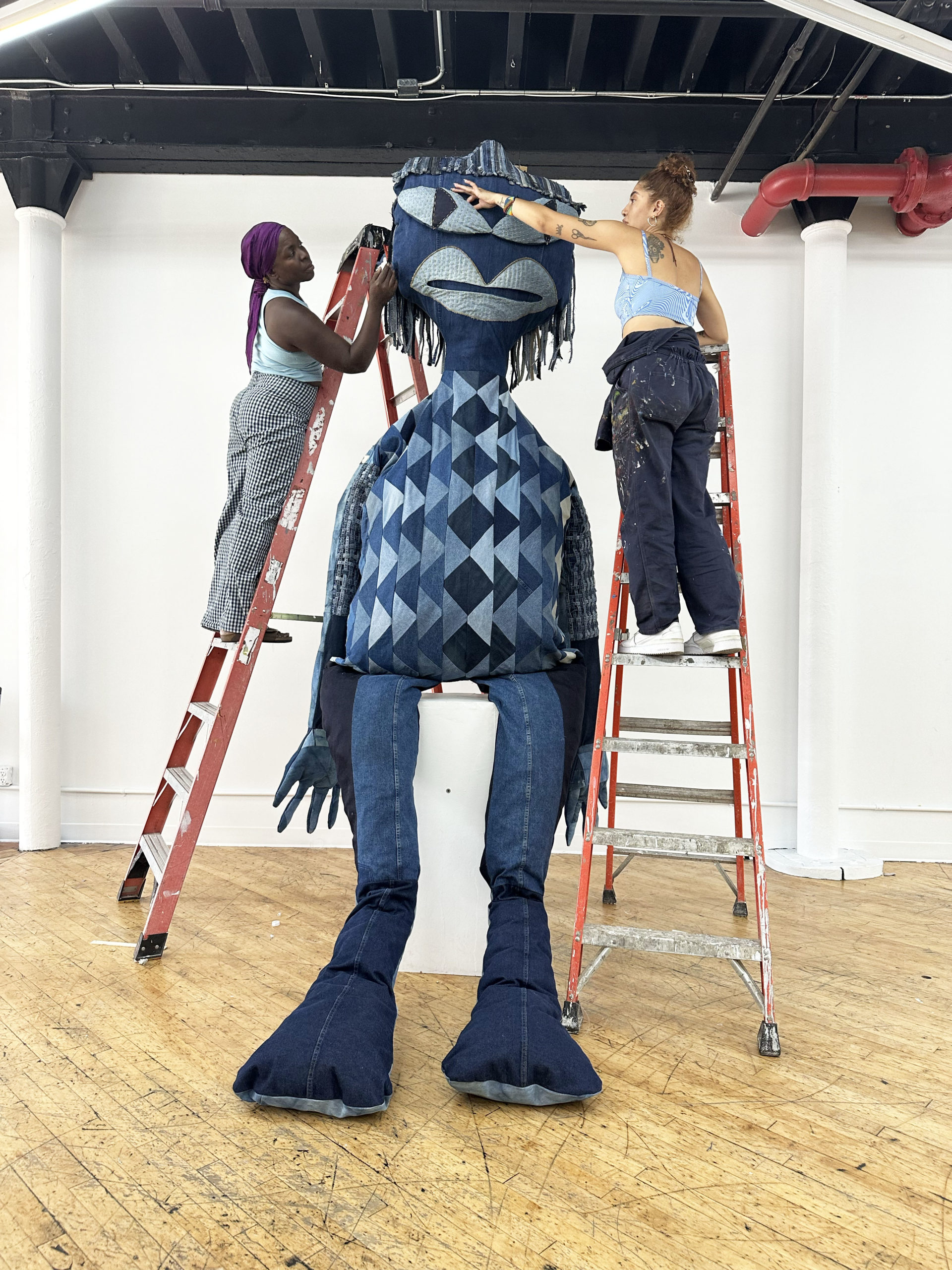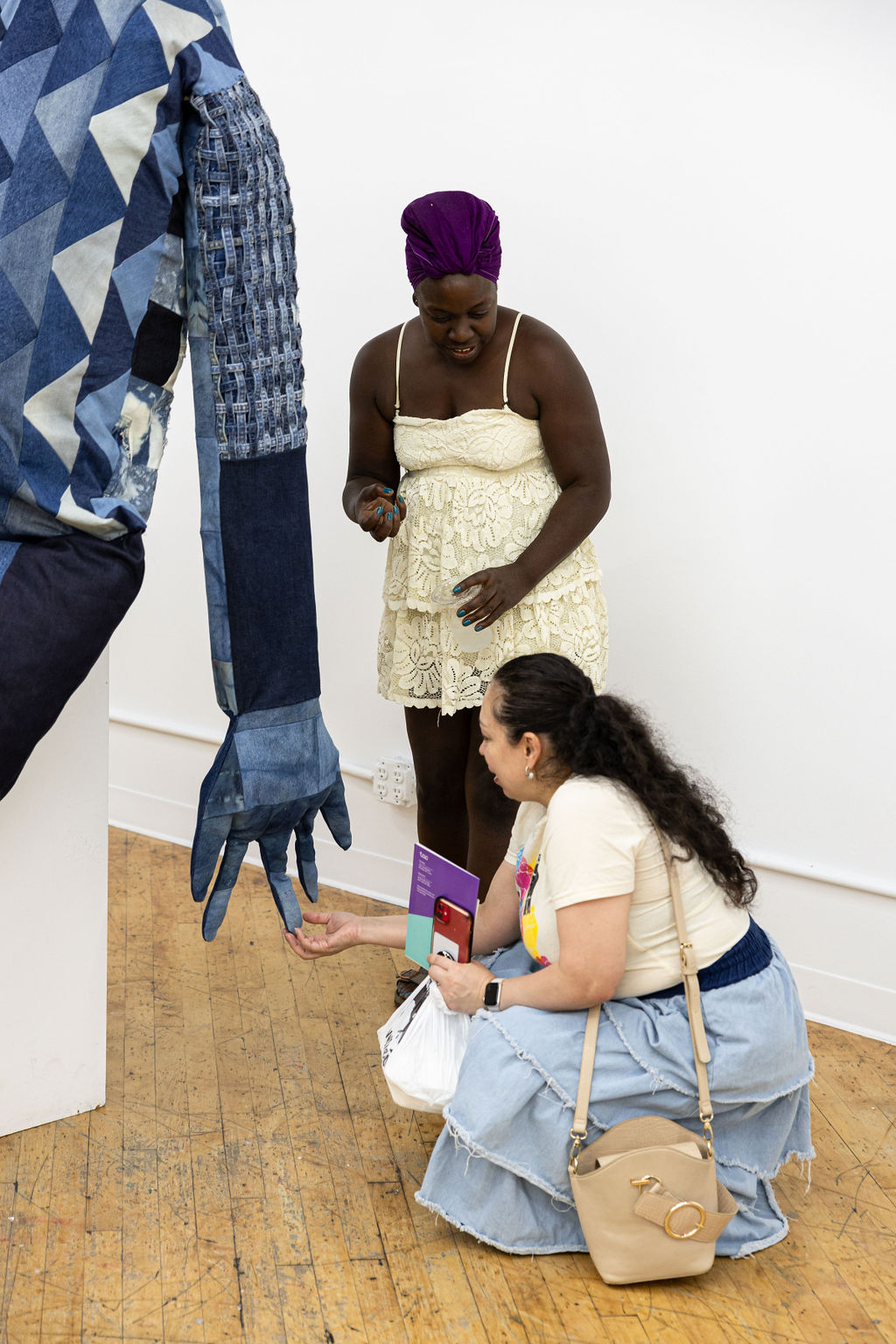AIR 14 Feature: Hekima Hapa
Hekima Hapa begins her artist statement with a direct and illuminative statement, “Often misunderstood in text.” Through the following lines, I’ll go through my interview with her, I’ll describe her work and do my best to put into words her energy and that of her practice. But that starting line resonates strongly in my head. So, take these words not as an intent of understanding her but as an invitation to join her on a sewing journey.
Hekima and I met at the peaceful corner of TAC's studio, next to its cute library—a corner hidden from everyone, the secluded home of the sun. While being touched by its solar rays, we talk. Listening to her explain what she does feels like being captivated by a spell with a sewing tune. By the end of our talk, I’m ready to pick up the needle. Sewers of the world, unite!
Hekima is a sewer, a fashion designer, and a storyteller. She tells me the story of her childhood, which reveals how her DNA is made of interviewed threads and needles. She explains that her mother sewed. She taught her and her siblings. She was a seamstress and worked from home. “I’m coming for the money she never made,” she exclaims after telling me she was underpaid. A call for economic justice reverberates in her.
Sewing tasks were included in the day-to-day when she was a child, mixed with the school’s homework. Her entire family sews. Her mother's sisters were quilters. “To stay connected, her sisters sent her parts of quilts they made.” After moving to different places, her family kept in touch through postal art. I can't help but picture a network of women taking the postal service with patchwork. She describes how those handmade blankets were hefty, making it extremely difficult to move in bed. What could exemplify best what it is to stay in touch rather than share things that exist next to our skins and bodies? “This had so much influence on who I am.” To use the works, having them enmeshed with daily activities instead of hanging them on a wall, forbidden to the touch, set the patterns on how she approaches her work. It’s meant to be grabbed, experienced, used. “It’s meant to be enjoyed.” A proposal that seems subversive to how some Western institutions have limited and defined our relation towards art.
But her work not only challenges a traditional Western sense of experiencing art. She also examines the consumption culture and how the textile industry is a major polluter. Fast fashion has created several dump sites that store tons of discarded clothes, creating a landscape of synthetic mountains that decorate the Global South in places such as the Atacama desert in Chile or the landfills denounced by Clean Up Kenya and the Changing Markets Foundation in Kenya. It’s the scenery of overproduction.
“Sustainability is an ancient way of life, use ALL fibers, ALL fabric scraps, and found materials because nothing can be wasted,” reads her statement.
Using every piece is something that she learned at home. Every scrap is valuable. Look into things that have already been created. Don’t get fooled. It’s not about producing a new dress made of sustainable cotton but about the dusty polyester shirt hidden deep in your closet. She has been collecting fabric donations for a project she has nurtured for over ten years, Black Girls Sew.
From a young age, she learned how empowering it was to make your own clothes. Her non-profit organization, Black Girls Sew, passes down those teachings. Youths learn how to use a sewing machine and how to do patterns. The workshops started in Bedstuy, the neighborhood still the non-profit’s home. It all began with a sewing machine given as a gift to her daughter. What continued from that was the result of a communal effort of dialogue and collective organization. That one gift evolved to become a ten kids class in a borrowed office, to now offering a series of workshops happening in several places. This year, the Brooklyn Free School joined to host some of them. Right at the beginning of our conversation, Hekima clarified, “Non-profit is my destiny.”

Growing up in a house where working with fibers was a second language, where textiles became a way of life, she learned to listen and understand the textile spirits. She lets herself surrender to the guidance of her ancestors, who speak to her in the quiet of the night. She defines herself as a messenger. The tasks sometimes seem gigantic, as her final piece for the Artist in Residency program shows. “The size, the shape just happened. This is what is supposed to be.” A 15 foot tall doll made out of denim. A creature that takes space, that makes herself present, symbolizing growth, the act of caring, ongoing gestation, and transformation. Her arms are weaved. Her eyes and mouth are done with sashiko, a traditional Japanese embroidery. For the doll, different pieces of patchwork were dyed with indigo several times. Four, eight, twelve times. A blue doll sits on the floor. “The depth of the blue has so many meanings…”
Indigo dye is obtained from the leaves of Indigofera tinctoria. The dye is difficult to obtain and understand. It needs to choose you. And it has chosen her. Hekima explains with clarity how it touches particular artists that can communicate its properties, “is just something about the blue that sits with you and bubbles in different ways. It visited me through denim, and then I worked backward.” Initially, she worked with denim, gathering blues from West Africa before doing her own dye batch. This is the first time she has collaborated with Indigo (the dye has agency, let’s not deny it) entirely. TAC gave her the space to explore the process, change the rhythm, and slow down to relate to the materials and her mediums deeper. This final piece, done at the end of her residency, has seen every stage of the journey.
Impregnating the doll relates to her time at TAC. How the program held her, received, and potentiated her growth. She explains how this residency allowed her to change. It was the space for her to evolve as an artist. A quilt with triangle shapes, similar to arrows, covers the doll's belly. Imagine a compass spinning, about to stop to indicate direction. Those triangles indicate a way in, a way out. Maybe an in-between. It is a symbol of being at the mercy of the spirits. “I’m being pushed around,” she says. It is for them to choose where she will go next, to transform space with her family, for her work is always collective. Zinga, Queen, Biko, and Garvey i are her closest collaborators. By creating together, they changed TAC's space, making it inviting to get involved in their process, to sit together with their spirits and create.
The arrow keeps on spinning.
Let’s keep an eye on her to see what she will create next.
Hekima Hapa is a Fashion Designer, social entrepreneur, author and Founder of the 22 year sustainable independent fashion brand inspired by Africa and the people of its diaspora, Harriet’s Alter Ego also known as Harriet’s by Hekima. In 2013, she founded Black Girls Sew, a nonprofit organization committed to positively impacting the lives of youth and families through education in sewing, design and entrepreneurship.

Bibliography
https://nypost.com/2023/06/20/chiles-desert-dump-for-60k-tons-of-fast-fashion-seen-from-space/